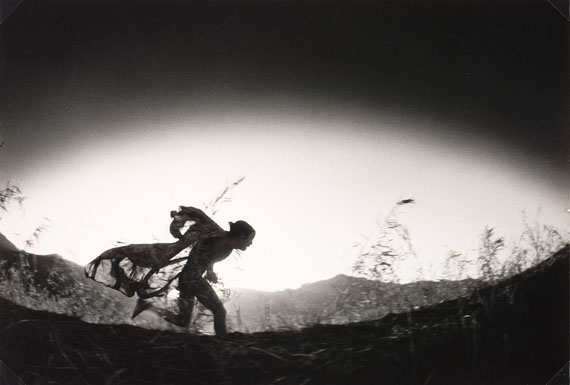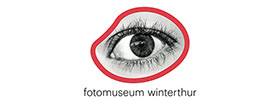
Provoke: Between Protest and Performance
Photography in Japan, 1960–1975
Nobuyoshi Araki » Koji Enokura » Eikoh Hosoe » Daidō Moriyama » Shômei Tômatsu » Okada Takahiko » Yutaka Takanashi »
Exhibition: 28 May – 28 Aug 2016
Fri 27 May 18:00

Fotomuseum Winterthur
Grüzenstr. 44+45
8400 Winterthur
+41 (0)52-2341060
info@fotomuseum.ch
www.fotomuseum.ch
Tue, Thu, Fri 11-17; Wed 11-20; Sat-Sun 11-18

Provoke: Between Protest and Performance
Photography in Japan, 1960–1975
Ausstellung: 28 May – 28 August, 2016
Opening: 27 May, 6pm
The Japanese photo magazine, Provoke, appeared for three issues between November 1968 and August 1969 and is regarded as one of the high points of post-war photography. In the largest ever exhibition devoted to the topic, Fotomuseum presents a close look at the magazine’s gestation, innovative aesthetics and the contribution of its key collaborators. The 1960s and 1970s were a turbulent period in Japanese history as workers, farmers and students protested the speed of modernisation and Japan’s alliance with the United States during the Cold War. The exhibition reveals how photography was deeply implicated in the aesthetic and political debates of the time, challenging and renewing older documentary forms. With around 250 objects, Provoke brings together photographs and publications by some of Japan’s most influential photographers, including Nobuyoshi Araki, Daidō Moriyama, Takuma Nakahira and Shōmei Tōmatsu.
Divided into three sections, the exhibition defines photography as performative, both in a political and artistic sense. It sets the emergence of Provoke against a backdrop of widespread social unrest, beginning in 1960 with extensive public protests against the renewal of a security treaty with the United States. The breakdown of parliamentary politics in Japan led to an explosion of counter-journalism, including the photographic production of the so-called "protest book". Made by trade unionists, students and environmental activists, the books documented 15 years of ferocious struggle, including anti-government demonstrations and the movement to expel American military bases from Japanese soil. Often rudimentary in their production and with innovative layouts, they capture the spirit of violent protest, developing an aesthetic of bodily immersion and disorientation. Along with the work of more established photographers, the protest book revolutionised realist aesthetics, overturning established humanist modes of documentary representation.
The magazine Provoke drew from this culture of turbulent renovation. Its makers – poet and art critic Takahiko Okada, theorist-photographers Takuma Nakahira and Kōji Taki, and photographers Yutaka Takanashi and Daidō Moriyama – believed that traditional reportage was exhausted and they sought out a visual language to renew the perception of a rapidly changing modernity. Focussing primarily on the urban environment, the three issues of Provoke asserted the ephemerality of photographic vision and its grounding in the performative presence of the photographer. Photography no longer reflected reality, but rather incited theoretical reflection on the relationship between art, language and society. Famously, the magazine developed an aesthetic of are-bure-boke (rough, blurred, out of focus), breaking with earlier objectivising modes of documentary humanism. Its contributors experimented with different modes of photographic reproduction, engaging in a fierce dialogue with other photographic media. The task was to renew image-making in a society increasingly dominated by media artifice.
Finally, the exhibition examines photography as a variant of Japanese performance art and its role in the documentation of performance. It includes collaborations between photographers and artists, such as that between Eikō Hosoe and the dancer Tatsumi Hijikata, as well as the work of collectives such as Hi Red Center who utilised photography and film in performance from 1964 as a mode of social critique. Others, including Nakahira, Araki and Kōji Enokura, portrayed darkroom work or other processes linked to photographic reproduction as active components of performative transformation. In Jirō Takamatsu’s rephotographing of photographs the almost sculptural aspects of the medium are reflexively identified. Photography is conceived as both provocation and performance, a philosophical and material exploration of the meanings of photochemical reproduction typical of 1970s’ conceptual art.
"Provoke: Between Protest and Performance – Photography in Japan, 1960–1975" is curated by Fotomuseum in collaboration with the Albertina, LE BAL and The Art Institute of Chicago. The exhibition is accompanied by a fully-illustrated, 680-page catalogue, published by Steidl. It includes essays by Duncan Forbes, Yukio Lippit, Walter Moser, and Matthew S. Witkovsky, artist interviews, key texts of the Provoke era translated into English, as well as reprints of the three Provoke issues.�

Provoke: Zwischen Protest und Performance
Fotografie in Japan 1960–1975
Ausstellung: 28. Mai bis 28. August 2016
Eröffnung: 27. Mai, ab 18 Uhr
Die japanische Zeitschrift Provoke erschien zwischen November 1968 und August 1969 in drei Ausgaben und gilt als einer der Höhepunkte der Fotografie der Nachkriegszeit. In der bisher grössten Ausstellung zu diesem Thema bietet das Fotomuseum einen umfangreichen Einblick rund um die Entstehungsgeschichte der Zeitschrift, ihre innovative Ästhetik und die massgeblich Beteiligten. Die 1960er und 1970er Jahre markieren eine turbulente Zeit in der japanischen Geschichte: Arbeiter, Bauern und Studenten protestierten nicht nur gegen die Geschwindigkeit, mit der die Modernisierung des Landes vorangetrieben wurde, sondern auch gegen Japans Bündnis mit den USA im Kalten Krieg. Die Ausstellung zeigt auf, wie stark die Fotografie in die ästhetischen und politischen Debatten der Zeit eingebunden war und ältere dokumentarische Formen hinterfragte und erneuerte. Mit rund 250 Objekten bringt Provoke Fotografien und Publikationen von einigen der einflussreichsten Fotografen Japans wie Nobuyoshi Araki, Daidō Moriyama, Takuma Nakahira und Shōmei Tōmatsu zusammen.
In der dreiteiligen Ausstellung wird die Fotografie sowohl im politischen als auch im künstlerischen Sinne als "performativ" definiert. Die Entstehung der Zeitschrift Provoke erscheint damit vor dem Hintergrund weit verbreiteter sozialer Unruhen, welche 1960 mit grossen öffentlichen Protesten gegen die Verlängerung eines Sicherheitsabkommens mit den USA ihren Anfang nahmen. Der Zusammenbruch der parlamentarischen Politik in Japan führte zur Explosion eines alternativen Journalismus, der unter anderem das fotografische "Protestbuch" hervorbrachte. Die Publikation wurde von Gewerkschaftlern, Studenten und Umweltaktivisten erstellt und dokumentiert 15 Jahre eines heftigen Kampfes, der Proteste gegen die Regierung und eine Bewegung zur Abschaffung von amerikanischen Militärstützpunkten auf japanischem Boden umfasste. Häufig sehr einfach produziert und innovativ gestaltet, fangen die Beiträge den Geist des gewaltsamen Protests ein und entwickeln eine Ästhetik körperlicher Anteilnahme und Entkopplung. Neben den Arbeiten der etablierteren Fotografen revolutionierte das "Protestbuch" durch seinen Umsturz der traditionellen humanistischen Formen dokumentarischer Darstellung auch die realistische Ästhetik.
Die Zeitschrift Provoke fand in dieser Kultur der turbulenten Erneuerung ihren Nährboden. Ihre Herausgeber, der Dichter und Kunstkritiker Takahiko
Okada, die Theoretiker/Fotografen Takuma Nakahira und Kōji Taki sowie die Fotografen Yutaka Takanashi und Daidō Moriyama glaubten, dass sich
die traditionelle Reportage erschöpft habe und suchten nach einer Bildsprache, mit der sich die Wahrnehmung einer sich rasant verändernden
Moderne erneuern liess. Mit einem Fokus auf das städtische Umfeld behaupteten die drei Ausgaben von Provoke das Ephemere des fotografischen
Blicks und seine Grundlage in der performativen Anwesenheit des Fotografen. Die Fotografie bildete nicht mehr die Realität ab, sondern war
zum Anreiz für theoretische Überlegungen zur Beziehung von Kunst, Sprache und Gesellschaft geworden. Berühmt wurde das Magazin auch für seine Ästhetik des are-bure-boke (rauh, körnig, unscharf), das mit älteren, objektivierenden Formen eines dokumentarischen Humanismus brach. In ihren Experimenten mit verschiedenen fotografischen Reproduktionsweisen lieferten sich die Beteiligten mit anderen fotografischen Medien einen Schlagabtausch. Ihre Aufgabe war die Erneuerung der Bildfindung in einer zunehmend von Medienkonstruktionen beherrschten Gesellschaft.
Schliesslich untersucht die Ausstellung die Fotografie als eine Variante der japanischen Performance-Kunst sowie ihre Rolle bei der Dokumentation von Live-Aktionen. Hier geht es unter anderem um Kollaborationen von Fotografen und Künstlern, wie im Fall von Eikō Hosoe und dem Tänzer Tatsumi Hijikata, aber auch um die Arbeiten von Kollektiven wie dem Hi Red Center, welches die Fotografie und den Film ab 1964 als Modus sozialer Kritik in Performances einsetzte. Wieder andere, zum Beispiel Nakahira, Araki und Kōji Enokura, zeigten die Arbeit in der Dunkelkammer und weitere Prozesse der fotografischen Reproduktion als aktive Bestandteile einer performativen Verwandlung. In Jirō Takamatsus Fotografien von Fotografien treten die beinahe plastischen Aspekte des Mediums reflexiv hervor. Die Fotografie wird sowohl als Provokation wie auch als Performance verstanden – als eine philosophische und materielle Auseinandersetzung mit der Bedeutung fotochemischer Reproduktionsprozesse, wie sie für die Konzeptkunst der 1970er Jahre typisch war.
"Provoke: Zwischen Protest und Performance – Fotografie in Japan 1960–1975" wurde vom Fotomuseum in Zusammenarbeit mit der Albertina, LE BAL und The Art Institute of Chicago kuratiert. Zur Ausstellung erscheint ein reich bebilderter, 680-seitiger Katalog (Steidl; Englisch, mit deutschem Begleitheft der Haupttexte). Mit Texten von Duncan Forbes, Yukio Lippit, Walter Moser, und Matthew S. Witkovsky, Interviews mit Künstlern, ins Englische übersetzte Texte der Provoke-Akteure sowie ein Abdruck der drei Ausgaben von Provoke.�

